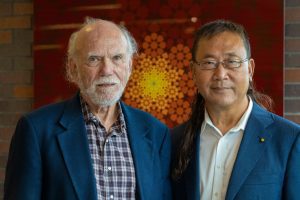Barry Barish, Nobel Prize in Physics Laureate and Distinguished Endowed Chair in Physics and Distinguished Professor in the Department of Physics and Astronomy at Stony Brook University, accepted a 2022 National Medal of Science (2022 and 2023 medals were presented at the same ceremony) from President Joe Biden on Oct. 24. Bestowed during a White House ceremony honoring U.S. scientists, technologists and innovators whose achievements have greatly benefited the country and beyond, this prestigious award is among the highest honors in the scientific community.
Professor Barish was acknowledged for his “exemplary service to science, including groundbreaking research on sub-atomic particles,” said the military aide who announced the awards. “His leadership of the Laser Interferometer Gravitational-Wave Observatory [LIGO] led to the first detection of gravitational waves from merging black holes, confirming a key part of Einstein’s Theory of Relativity. He has broadened our understanding of the universe and our nation’s sense of wonder and discovery.”
In addition to his roles at Stony Brook, which he assumed earlier this fall, Professor Barish is also an esteemed educator at the California Institute of Technology (Caltech) and the University of California, Riverside, as well as a member of the National Academy of Sciences (NAS), the American Academy of Arts and Sciences, the American Association for the Advancement of Science, and the American Physical Society (APS), where he also served as president. His growing legacy in the field of physics has earned him a long list of accolades, including the 2017 Nobel Prize in Physics, which he shared with LIGO colleagues Rainer Weiss and Kip S. Thorne. He has also received a Copernicus Prize from the government of Poland, a Henry Draper Medal from the NAS, and many more awards for his work.
“The National Medal of Science presented to Professor Barish, Stony Brook’s inaugural President’s Distinguished Endowed Chair in Physics, is the latest honor marking his exceptional career dedicated to discovery, innovation and excellence,” said Maurie McInnis, president. “Joined by President Biden and other scientists and innovators during the White House ceremony, it was a proud moment for Stony Brook as he received the nation’s highest honors for science. He is truly an inspiration to his students and colleagues, and I am grateful for his teaching and mentorship that inspires all of us by his example.”
After receiving a doctorate in physics from his alma mater, the University of California, Berkeley, in 1962, Professor Barish stayed as a research fellow before taking on a fellowship with Caltech. His early career focused on high-energy physics, and he is associated with several key discoveries about the nature and behavior of microscopic particles. In the decades since, his innovative work has transcended particle physics itself to impact all sorts of specialties – from astrophysics to cosmology – making him one of the most influential physicists of his time.
“Even as a life-long particle physicist myself, it is awe-inspiring to think that human beings can detect ripples in space-time (gravitational waves) that Einstein dreamed about from two merging black holes, since even a black hole itself is incomprehensible to many of us,” said Chang Kee Jung, Distinguished Professor and Chair of the Department of Physics and Astronomy. “Every time I think about it, I get goose bumps! Although this medal recognizes Barry’s scientific achievements, it also recognizes his broader contributions to the US scientific community through his services on key committees, panels and leadership positions, such as the President of APS. We are lucky to have him here at Stony Brook. Even with his packed schedule, recently he volunteered to teach an undergraduate course in addition to his graduate course, demonstrating his unwavering passion and dedication for teaching and education. He is an inspiration to all of us.”
The National Medal of Science and National Medal of Technology and Innovation were each awarded to a handful of high-achieving American thought leaders.







